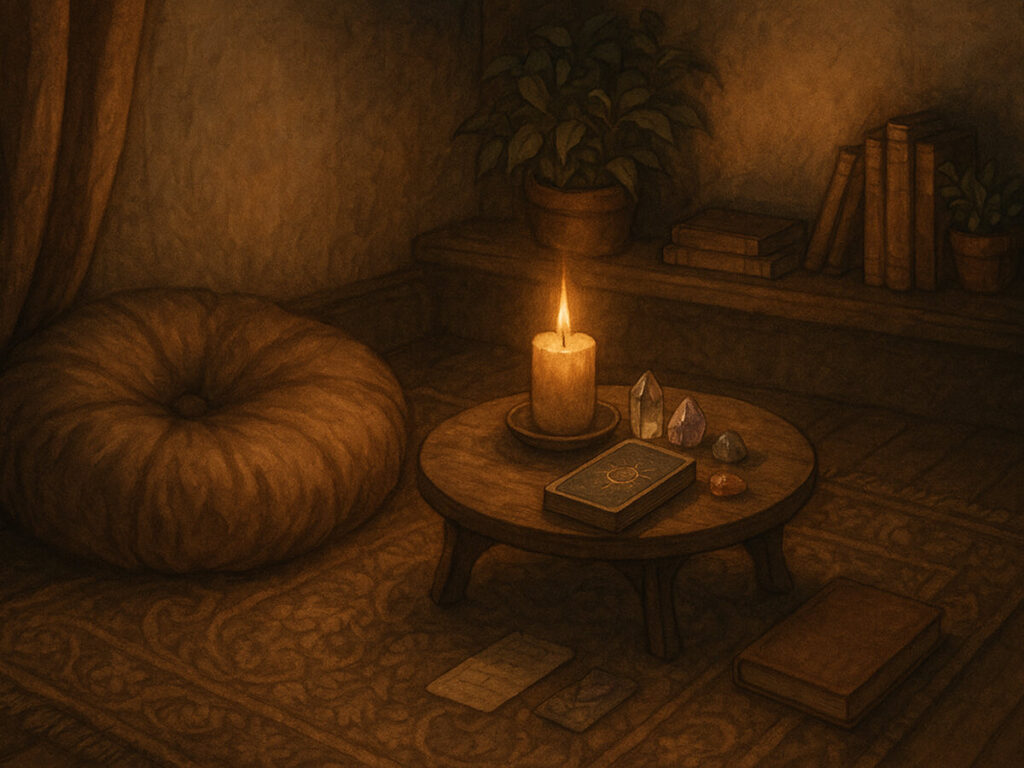How to Create a Sacred Space for Tarot Reading


Table of Contents
Did you know that 78% of experienced tarot readers believe that having a dedicated sacred space significantly improves their reading accuracy? I certainly found this to be true in my own practice. When I first started reading tarot over 30 years ago, I would simply pull cards at my kitchen table, wondering why my readings sometimes felt disconnected. Everything changed when I created my first sacred space.
Welcome to the mystical world of tarot sacred spaces! I’m Miranda Starr, and after four decades of tarot experience, I’ve learned that the environment where you practice is just as important as the cards themselves. Your sacred space serves as a bridge between the physical and spiritual realms, creating a sanctuary where intuition flows freely and divine guidance becomes clearer.
In 2025, we’re seeing a beautiful renaissance of interest in creating personalized sacred spaces that honor both ancient traditions and modern practicality. Whether you have an entire room to dedicate or just a small corner in your apartment, this guide will help you establish a space that enhances your connection with the cards and elevates your tarot practice.
I remember my first proper sacred space—a tiny corner of my bedroom with nothing but a purple cloth, a single crystal, and my beloved deck. Even that simple setup transformed my readings! Now I’ll share what I’ve learned through decades of practice to help you create a space that resonates with your unique spiritual journey.
Let’s embark on this magical journey together, exploring how to create a space that not only houses your tarot practice but also nurtures your intuition and spiritual growth. By the end of this article, you’ll have all the knowledge you need to craft a sacred space that feels authentically yours and powerfully supports your tarot work.
Unveiling the Power of Sacred Spaces for Tarot Practice
There’s something almost magical that happens when you step into a properly prepared sacred space. I still remember the first time I entered a true tarot sanctuary. It was my mentor Eliza’s reading room back in 1987. The moment I crossed the threshold, I felt a distinct shift in energy, like walking through an invisible veil. My senses heightened, my mind quieted, and I could almost hear the whispers of wisdom waiting to be channeled.
Sacred spaces for divination aren’t a modern invention. Throughout history, cultures worldwide have designated special areas for communing with spiritual forces. Ancient Egyptian priests conducted divination rituals in temple sanctuaries, while Celtic druids created sacred groves for their prophetic practices. According to the Journal of Esoteric Studies, these dedicated spaces serve as “energetic containers that concentrate and preserve spiritual energy, creating optimal conditions for divination work.”
I’ve found that having a dedicated space creates a powerful psychological trigger too. After years of consistent practice in my sacred space, just sitting at my reading table automatically shifts my consciousness into a receptive state. It’s like my mind knows, “This is where we do the deep work.” This psychological readiness is particularly important for beginners who are still developing their intuitive muscles.
The energetic separation is equally important. Our homes are filled with the energy of daily life: work stress, family dynamics, and mundane concerns. A designated sacred space creates an energetic boundary that helps you step away from these everyday vibrations. I’ve had clients who struggled with their readings until they created even a small dedicated area that was energetically distinct from their living spaces.
How does this work on an energetic level? Spiritual teacher Marianne Woodward explains, “Regular spiritual practice in a specific location imprints that space with intentional energy, creating an energetic reservoir that becomes increasingly powerful over time.” I’ve experienced this firsthand. My current reading room has been my sacred space for over 15 years, and visitors often comment on the palpable sense of peace they feel upon entering.
For skeptics wondering if this really matters, I suggest a simple experiment I often recommend to my students: Try doing the same reading spread twice. Once in your busy living room during normal household activities, and once in a quiet, dedicated space prepared with intention. The difference in clarity and depth is usually remarkable.
Essential Elements for Your Personal Tarot Sanctuary
Creating your tarot sanctuary doesn’t require a massive budget or dedicated room (though those things are nice!). When I started teaching tarot in the early 90s, I was living in a tiny studio apartment, and my “sacred space” was a repurposed TV tray in the corner! What matters most is intention and a few key elements that transform ordinary space into something magical.
First, location is crucial. I learned this lesson the hard way when I initially set up my reading area in a high-traffic spot near my front door. The constant movement and interruptions made deep concentration nearly impossible. If possible, choose a quiet corner away from busy areas of your home. Pay attention to how different spaces feel energetically—some spots naturally feel more peaceful or charged than others. Trust your intuition here; your body knows where it feels most centered.
Every sacred space needs a foundation—literally. In my experience, having a dedicated surface for readings creates a focal point for your practice. This could be a special table, a shelf altar, or even a beautiful cloth spread on the floor. I’ve used everything from antique writing desks to simple wooden crates covered with velvet. The key is consistency and intention.
The four elements provide a powerful framework for balancing your space. Earth (crystals, plants, salt), Air (incense, feathers, bells), Fire (candles, light), and Water (small fountain, seashells, a bowl of water) each contribute unique energies. I always include at least one representation of each element in my space. My rose quartz sphere (Earth) has been part of my sacred space for over 20 years, while my reading candle (Fire) gets replaced regularly as it burns down.
Storage solutions are often overlooked but incredibly important. Your cards absorb energy, so having a dedicated storage space protects them from scattered household energies. I keep my professional decks in a cedar chest within my sacred space, each wrapped in natural fabric. Some of my students use special boxes, shelves, or drawers dedicated solely to their tarot tools.
Seating deserves special consideration too. You’ll spend significant time in your sacred space, so physical comfort supports spiritual comfort. I learned this lesson after developing back problems from hunching over cards on a too-low table! Choose seating that allows good posture and physical ease during long reading sessions.
Don’t forget about lighting—natural light is wonderful, but being able to control the atmosphere with softer lighting often helps with focus. I use a combination of candles and a small lamp with a dimmer switch to create the perfect ambiance for different types of readings.
Remember, your sacred space will evolve with your practice. My current space bears little resemblance to where I started, having grown and shifted as my relationship with tarot deepened. The most important element is that it feels right to you—a place where you can breathe deeply, center yourself, and connect with your intuitive wisdom.
Energetic Cleansing Rituals for Your Tarot Space
I’ll never forget the time I conducted a particularly heavy reading involving a client’s grief process and then attempted another reading immediately after. The residual energy was so thick I could barely connect with the new questions. That experience taught me one of the most important lessons about maintaining a tarot sacred space: regular energetic cleansing isn’t optional, it’s essential.
Smoke cleansing remains one of the most effective methods for clearing space. While white sage has become commercially popular, I’ve found that different plants work better for different purposes. Cedar creates protective energy, rosemary purifies and promotes mental clarity, and lavender brings calm and peace. Whatever you choose, the process is similar: light your bundle, let it smolder, then walk clockwise around your space, allowing the smoke to reach all areas while setting clear intentions for cleansing.
Sound cleansing offers another powerful approach. The vibrations from bells, singing bowls, or even clapping hands can break up stagnant energy patterns. I keep a small brass bell in my sacred space specifically for this purpose. Before important readings, I ring it in each corner of the room, visualizing the sound waves dissolving any energetic residue. As Dr. Mitchell Gibson notes in his book “The Enlightened Mind,” “Sound vibrations physically alter the environment at the subatomic level, restructuring energy patterns that have become disharmonious.”
Crystals can work continuously to maintain your space’s energy. I’ve arranged a simple grid in my reading room using black tourmaline in the corners for protection, clear quartz for amplification, and amethyst near my reading table for spiritual connection. I cleanse these monthly under the full moon, a practice I’ve maintained for decades. Even on days when I don’t have time for elaborate cleansing rituals, this crystal grid works silently in the background.
Water is remarkably effective for energetic reset. I keep a small spray bottle with moon-charged water and a few drops of essential oil (usually lemon or frankincense) to mist my space between readings. For deeper cleansing, try the traditional witch’s bottle method: fill a bowl with water and sea salt, place it in your space overnight to absorb negative energy, then pour it away outside the next morning, visualizing it carrying away any unwanted influences.
Perhaps the most underutilized cleansing tool is visualization. I spend a few minutes before and after using my sacred space to visualize bright light filling the area, dissolving any lingering energies. This practice costs nothing and requires no supplies, yet I’ve found it remarkably effective, especially when combined with intentional breathing.
Timing your cleansing with natural cycles enhances its effectiveness. New moons support banishing unwanted energies, while full moons amplify purification. I’ve noticed my spring equinox cleanings always feel particularly powerful, a natural time for fresh starts and renewed energy.
Whatever methods you choose, consistency matters more than elaborateness. A simple daily practice maintains clearer energy than occasional intensive cleansing. As my mentor once told me, “The magic isn’t in the tools, Miranda. It’s in your intention and attention.”
Personalizing Your Sacred Space with Meaningful Symbols
The most powerful sacred spaces resonate with personal meaning. I learned this lesson years ago when I visited a colleague’s elaborate tarot room filled with traditional occult symbols that meant nothing to her personally. Despite its visual impressiveness, the space felt oddly empty. Contrast this with another reader whose simple space included her grandmother’s handkerchief, a stone from a meaningful location, and a feather from her backyard—that space practically hummed with power.
Your spiritual symbols should reflect your authentic path. While traditional tarot imagery like the sun, moon, and stars work beautifully, don’t hesitate to incorporate symbols from your cultural heritage or personal spiritual journey. My sacred space includes both a statue of Hermes (traditional patron of divination) and a small painting of the Oregon coast where I experienced a profound spiritual awakening. This combination feels genuinely mine.
Color psychology plays a surprisingly important role in sacred spaces. Different colors activate different energetic responses—blues promote calm and intuition, purples enhance spiritual connection, while reds stimulate energy and passion. I actually change the cloths on my reading table based on the type of reading I’m doing: purple for spiritual questions, green for growth and healing work, and indigo for deep intuitive dives into complex situations. Pay attention to your own responses to colors and choose those that support your particular tarot practice.
Natural elements create powerful connections to the earth’s wisdom. I’ve collected small stones from significant locations in my spiritual journey and arranged them on my altar. Plants bring literal life force into your space—my small pothos plant has been with me through three moves and countless readings! Even a simple bowl of water can serve as a reminder of emotional flow and intuitive depth.
Personal power objects often find their way into sacred spaces. These might be family heirlooms, gifts from mentors, or items you’ve discovered that carry special energy. My reading glasses case was made by my grandmother, and having this connection to my ancestral lineage strengthens my work. Sometimes the most unlikely objects carry the strongest energy—one of my students uses a baseball from her father’s collection as a grounding tool during difficult readings.
Seasonal adjustments keep your space energetically aligned with natural cycles. I change certain elements of my sacred space with the wheel of the year—adding spring flowers in April, seashells in summer, autumn leaves in fall, and evergreen branches in winter. These small adjustments honor the shifting energies of the natural world and keep my practice connected to larger cosmic rhythms.
Remember that your space will evolve as you do. Some symbols that feel powerful when you begin may later feel less resonant as your practice deepens. Trust this process. I periodically assess my sacred space, asking myself honestly what still carries meaning and what might be released to make room for new energy. This practice of intentional curation ensures your space remains a living, breathing extension of your spiritual work.
Creating Spiritual Boundaries in Your Tarot Sacred Space
I once had a powerful lesson about spiritual boundaries when a casual acquaintance wandered into my reading room without permission and began handling my cards. The energetic disturbance was so significant that I had to perform a full cleansing ritual before I could work again. Creating and maintaining boundaries isn’t just about physical space—it’s about energetic integrity.
Physical boundaries represent your first line of protection. If possible, your sacred space should have a door you can close or a screen you can place to separate it from the rest of your living area. If you share your home with others, clear communication about respecting this space is essential. I have a simple “reading in progress” sign I hang when I need complete privacy. Even in shared spaces, you can create psychological boundaries with room dividers, curtains, or simply a change in decor that signals “this area is different.”
Energetic protection rituals should become second nature before you begin any tarot work. I start every session by visualizing a sphere of golden light surrounding my space, allowing in only energies that serve the highest good. Some practitioners cast a formal circle, while others use simpler methods like lighting a protection candle or spritzing the area with protective herbs. The specific technique matters less than your consistent intention to create energetic boundaries.
Time boundaries help maintain the sanctity of your practice. When I first began reading professionally, I would schedule sessions back-to-back, leaving no time to reset the energy between clients. I quickly learned this was energetically unsustainable. Now I always allow at least 15 minutes between readings to clear the previous energy and recenter myself. Similarly, having designated times for entering your sacred space helps train both your energy and the space itself to shift into “sacred mode.”
Respectful invocation and dismissal of spiritual energies forms another important boundary. I begin each reading by explicitly inviting supportive energies to assist, and I end by thanking them and releasing them. This practice acknowledges that we’re working with forces beyond ourselves while maintaining healthy boundaries about when that interaction begins and ends. As spiritual teacher Sandra Ingerman writes, “We must be as careful with our spiritual boundaries as we are with our physical ones.”
Managing lingering energies between different types of readings requires attention. Moving from a career reading to a spiritual guidance session without resetting the energy can create confusion. I use a simple bell ring between different types of questions, even within the same reading, to create energetic separation. This small ritual helps maintain clarity and prevents energetic bleed-through.
Perhaps most importantly, your sacred space needs protection from your own everyday concerns. I found that bringing my daily worries into my reading space diminished its power. Now I have a simple threshold ritual—I pause before entering, take three deep breaths, and consciously set aside personal concerns before crossing into my sacred space. This mental boundary-setting helps maintain the special energy I’ve cultivated there.
Remember that boundaries aren’t walls—they’re semipermeable membranes that allow the right energies to flow while keeping disruptive influences at bay. Finding this balance takes practice and attention, but it’s essential for maintaining a truly functional sacred space.
Modern Approaches to Portable Tarot Sacred Spaces
The world has changed dramatically since I began my tarot journey. Many of us now lead lives that require flexibility and mobility. I discovered the need for portable sacred space when I began traveling for workshops in the mid-90s. That first makeshift travel altar—a bandana, a tea light, and a small crystal—taught me that sacred space is ultimately about intention rather than location.
Creating a travel-friendly sacred space kit allows you to maintain your practice anywhere. Mine fits in a small drawstring bag and includes a dedicated cloth (which serves as both altar covering and card wrapping), a small white candle, a tiny bell, one versatile crystal (usually clear quartz), and a vial of protective essential oil blend. Some practitioners include miniature representations of their home altar or small photos of their full sacred space to help establish energetic continuity.
Digital sacred spaces have become increasingly relevant, especially for those offering online readings. I was initially resistant to this concept until a three-month period when I needed to conduct all my readings virtually. I discovered that with proper preparation, digital space can indeed become sacred. Creating a digital altar background, using specific music to signal the shift into sacred work, and having opening and closing rituals specifically designed for online work can transform your digital environment. As one of my colleagues aptly put it, “Energy flows where intention goes—even through the internet.”
Establishing sacred space in public settings requires subtlety and creativity. When I occasionally read at events, I bring a special scarf that I’ve dedicated solely to creating boundaries in public spaces. Spread on any table, it immediately defines my working area. Small, inconspicuous markers of the four elements can be placed at the corners—perhaps a tiny crystal, a feather tucked into your notebook, a battery tea light, and a small vial of water. These subtle tools create energetic definition without drawing unwanted attention.
For those in small living environments, the challenge becomes creating a sacred feeling without dedicated physical space. One of my apartment-dwelling students uses a beautiful wooden box that contains all her tarot tools. When opened and set up, it transforms whatever surface it’s on into a temporary sacred space. When closed, it can be stored away, allowing the area to return to everyday use. The ritual of opening this box signals to both her conscious and subconscious mind that sacred work is beginning.
Energetic techniques become especially important when physical tools are limited. Strong visualization skills can create a sacred container anywhere. I teach my students to visualize a column of light descending from above, expanding to create a sacred sphere around their working space. This technique requires no physical tools and can be employed anywhere, from airport lounges to coffee shops.
The essence of portable sacred space is finding the minimum effective elements that trigger your shift into sacred consciousness. For some, it might be a special pen used only for tarot journaling; for others, a particular scent that signals “sacred time.” Through experimentation, you’ll discover your own portable sacred space essentials—the elements that help you connect with tarot wisdom regardless of your physical location.
Your Sacred Space Journey Begins Now
Creating your tarot sacred space is a deeply personal journey—one that evolves alongside your spiritual practice. As we’ve explored throughout this guide, sacred spaces serve as powerful containers for your intuitive work, enhancing your connection to the cards and the wisdom they channel. Whether you’ve crafted an elaborate dedicated room or a portable altar that travels with you, the most important element remains your intention.
Throughout my four decades working with tarot, I’ve seen my sacred spaces transform countless times—from that first humble corner with a purple cloth to my current dedicated reading room. Each iteration taught me something valuable about what nurtures my connection to the cards. Your journey will undoubtedly follow its own unique path.
Remember that creating sacred space isn’t about perfection or following rigid rules. It’s about discovering what resonates with your authentic spiritual voice. As tarot historian Robert Place notes, “The most powerful magical spaces reflect the individual practitioner’s true spiritual nature rather than borrowed formulas.”
I encourage you to approach the creation of your sacred space with both reverence and playfulness. Experiment with different elements, observe how they affect your readings, and trust your intuition about what belongs in your space. The relationship between reader, cards, and sacred space is dynamic and ever-evolving.
In 2025, we’re fortunate to have both ancient wisdom and modern innovations available to us as we create our sacred spaces. Whether you’re drawn to traditional practices or cutting-edge approaches, the underlying principles remain consistent: intention, boundaries, personal meaning, and energetic maintenance.
May your sacred space become a true sanctuary—a place where the veils between worlds thin, where wisdom flows freely, and where you can connect deeply with your intuitive gifts. As you develop and nurture this special container for your practice, it will repay your attention many times over, enhancing every aspect of your tarot journey.
Frequently Asked Questions
How often should I cleanse my tarot sacred space?
I recommend a light cleansing before and after each reading session, using simple methods like ringing a bell or visualization. More thorough cleansings (with smoke, sound, or water) should be done weekly if you read regularly, or after particularly intense readings. Additionally, performing a deep cleansing during key moon phases or seasonal transitions (4-8 times yearly) helps maintain optimal energy.
Can I use my bedroom as a tarot sacred space?
Yes, but with some considerations. Bedrooms carry strong personal energy and associations with sleep, rest, and intimacy. If using your bedroom, try to create a distinct area that feels separate from your sleeping space. Use a room divider, different lighting, or even rearrange furniture slightly when doing readings. I also recommend more frequent cleansing when working in multipurpose spaces to help maintain clear energetic boundaries.
What should I do if someone enters my sacred space without permission?
First, calmly explain the importance of this being a dedicated space. Afterward, perform a simple cleansing ritual—this might be as basic as ringing a bell in each corner or using a visualization to reset the energy. If the cards were touched, consider giving them a cleansing as well. Use this as an opportunity to establish clearer boundaries about your sacred space with household members.
Is it bad luck to let others handle my tarot cards?
This varies by tradition and personal practice. In my experience, it’s less about “bad luck” and more about energetic imprints. Your cards attune to your energy with use. When others handle them, they leave their energetic signature, which can create “static” in readings. I have separate decks for personal use and decks I allow clients to shuffle. If you do let others handle your cards, cleanse them afterward with moonlight, crystal placement, or knocking on the deck to reset the energy.
How do I know if my sacred space has negative energy?
Trust your intuition—if something feels “off,” it probably is. Physical signs include feeling suddenly tired or uncomfortable in the space, readings becoming consistently unclear or negative, or experiencing unusual technical difficulties during sessions. You might notice plants wilting, candles burning unevenly, or persistent shadows. If you suspect negative energy, perform a thorough cleansing using multiple methods (smoke, sound, salt, and visualization) and consider adding protective elements like black tourmaline or protective symbols.
Can I create a sacred space if I practice tarot secretly from family members?
Absolutely. Many practitioners need discretion for various reasons. Consider portable options that can be quickly set up and put away, such as a special cloth and minimal tools stored in a decorative box that won’t draw attention. Digital sacred spaces work well for those needing privacy. You might also create a “stealth altar” using items that appear decorative to others but hold special meaning for you. Remember that much of sacred space creation happens through intention rather than physical objects.






